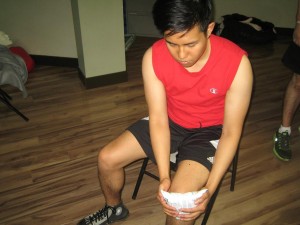Abrasion is basically a break in the surface of the skin where the epidermis has been scraped or broken and categorized as superficial wounds in the skin. There is mild oozing of blood and can be painful. Abrasions can cause severe pain because there are many nerve endings that are exposed. Abrasions usually occur in the knees, elbows and the ankle because the skin is thin and sometimes the padded areas can also be affected.
Abrasions are common in children because they are active and always playing and this injury can occur such as during accidental falls and rubbing of the skin against a rough surface while playing.
Even though an abrasion is considered as a minor injury, it should not be ignored since dirt, splinters and foreign body that are embedded in the skin surface can become breeding grounds for bacteria.

Abrasion is usually treated by antiseptics and leaving it to dry. A bandage is applied in order to avoid irritation caused by rubbing of clothes on the skin. Take note that abrasion usually heals within 4-5 days. If you want to properly manage an abrasion, all you have to do is register for first aid training in your area today.
Treatment and home remedies
- Remove embedded materials using sterilized tweezers. You can clean the tweezers by rubbing it with alcohol at least for 5 minutes or clean it using hydrogen peroxide.
- If there is bleeding, place a clean cloth or bandage against the affected area for 15 minutes.
- Wash the wound using warm water and soap in order to remove dirt and debris. Place the affected area under cool running water and place a few drops of liquid soap on a piece of cloth and continue rubbing the wound gently. A bath or a shower is the best way to clean the wound.
- Hydrogen peroxide can also be used in cleaning the wound, the bubbling effects of hydrogen peroxide helps in preventing infection.
- Apply aloe Vera leaves or extracts on the affected area. Take note that aloe Vera has antibacterial and anti-inflammatory properties that help promote fast healing of the wound.
- Thyme tea can also be used in washing and disinfecting the wound.
- Apply calendula cream in order to minimize bacteria from spreading into the deeper layers of the skin.
- Observe for any symptoms of infections such as fever, swelling or redness and if any of these are present, seek medical help immediately.
- A tetanus shot is administered if dirt and debris are embedded under the skin.
- Apply an antibiotic ointment on the affected area or an over-the-counter antibiotic ointment in order to keep the skin moist, prevent it from cracking and minimize chances of infection.
- Cover the affected area with a bandage or gauze in order the keep the affected areas clean and protected from bacteria.
